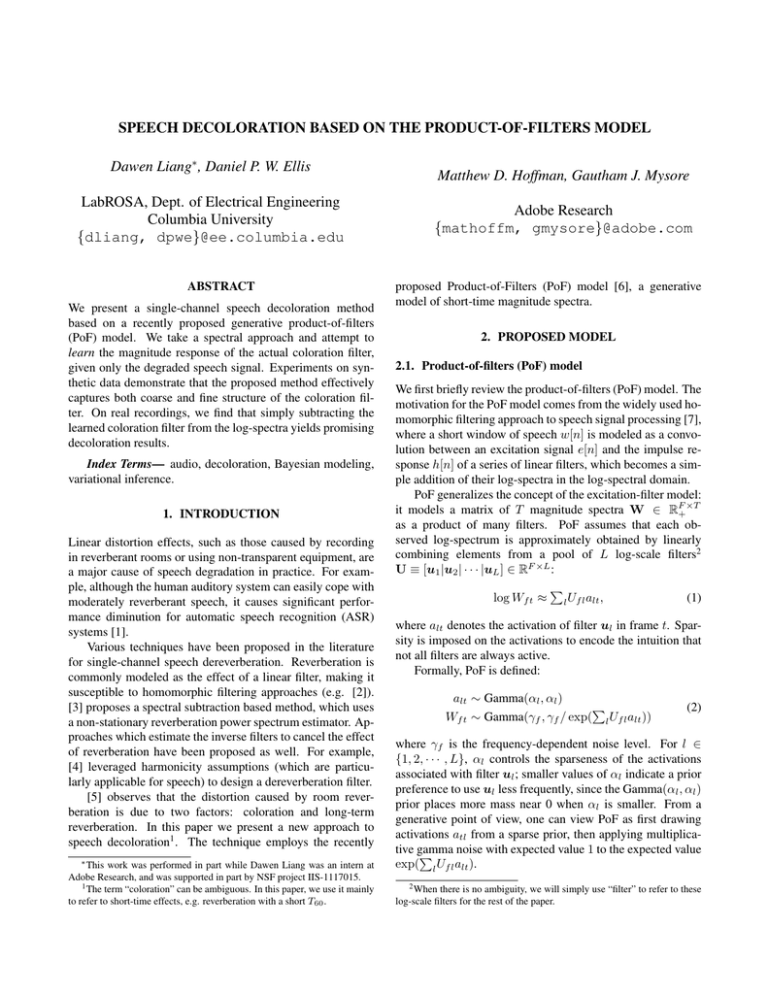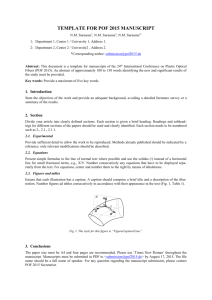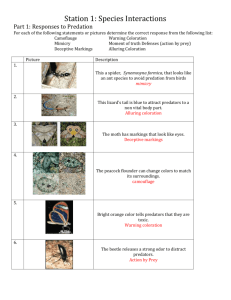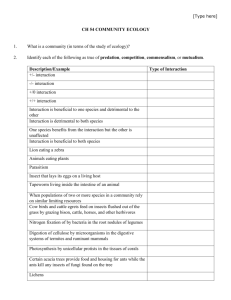SPEECH DECOLORATION BASED ON THE PRODUCT-OF-FILTERS MODEL Dawen Liang
advertisement

SPEECH DECOLORATION BASED ON THE PRODUCT-OF-FILTERS MODEL
Dawen Liang∗ , Daniel P. W. Ellis
LabROSA, Dept. of Electrical Engineering
Columbia University
{dliang, dpwe}@ee.columbia.edu
ABSTRACT
We present a single-channel speech decoloration method
based on a recently proposed generative product-of-filters
(PoF) model. We take a spectral approach and attempt to
learn the magnitude response of the actual coloration filter,
given only the degraded speech signal. Experiments on synthetic data demonstrate that the proposed method effectively
captures both coarse and fine structure of the coloration filter. On real recordings, we find that simply subtracting the
learned coloration filter from the log-spectra yields promising
decoloration results.
Index Terms— audio, decoloration, Bayesian modeling,
variational inference.
1. INTRODUCTION
Linear distortion effects, such as those caused by recording
in reverberant rooms or using non-transparent equipment, are
a major cause of speech degradation in practice. For example, although the human auditory system can easily cope with
moderately reverberant speech, it causes significant performance diminution for automatic speech recognition (ASR)
systems [1].
Various techniques have been proposed in the literature
for single-channel speech dereverberation. Reverberation is
commonly modeled as the effect of a linear filter, making it
susceptible to homomorphic filtering approaches (e.g. [2]).
[3] proposes a spectral subtraction based method, which uses
a non-stationary reverberation power spectrum estimator. Approaches which estimate the inverse filters to cancel the effect
of reverberation have been proposed as well. For example,
[4] leveraged harmonicity assumptions (which are particularly applicable for speech) to design a dereverberation filter.
[5] observes that the distortion caused by room reverberation is due to two factors: coloration and long-term
reverberation. In this paper we present a new approach to
speech decoloration1 . The technique employs the recently
∗ This work was performed in part while Dawen Liang was an intern at
Adobe Research, and was supported in part by NSF project IIS-1117015.
1 The term “coloration” can be ambiguous. In this paper, we use it mainly
to refer to short-time effects, e.g. reverberation with a short T60 .
Matthew D. Hoffman, Gautham J. Mysore
Adobe Research
{mathoffm, gmysore}@adobe.com
proposed Product-of-Filters (PoF) model [6], a generative
model of short-time magnitude spectra.
2. PROPOSED MODEL
2.1. Product-of-filters (PoF) model
We first briefly review the product-of-filters (PoF) model. The
motivation for the PoF model comes from the widely used homomorphic filtering approach to speech signal processing [7],
where a short window of speech w[n] is modeled as a convolution between an excitation signal e[n] and the impulse response h[n] of a series of linear filters, which becomes a simple addition of their log-spectra in the log-spectral domain.
PoF generalizes the concept of the excitation-filter model:
×T
it models a matrix of T magnitude spectra W ∈ RF
+
as a product of many filters. PoF assumes that each observed log-spectrum is approximately obtained by linearly
combining elements from a pool of L log-scale filters2
U ≡ [u1 |u2 | · · · |uL ] ∈ RF ×L :
P
log Wf t ≈ l Uf l alt ,
(1)
where alt denotes the activation of filter ul in frame t. Sparsity is imposed on the activations to encode the intuition that
not all filters are always active.
Formally, PoF is defined:
alt ∼ Gamma(αl , αl )
P
Wf t ∼ Gamma(γf , γf / exp( l Uf l alt ))
(2)
where γf is the frequency-dependent noise level. For l ∈
{1, 2, · · · , L}, αl controls the sparseness of the activations
associated with filter ul ; smaller values of αl indicate a prior
preference to use ul less frequently, since the Gamma(αl , αl )
prior places more mass near 0 when αl is smaller. From a
generative point of view, one can view PoF as first drawing
activations atl from a sparse prior, then applying multiplicative gamma
noise with expected value 1 to the expected value
P
exp( l Uf l alt ).
2 When there is no ambiguity, we will simply use “filter” to refer to these
log-scale filters for the rest of the paper.
Variational inference [8] is adopted to infer the activation
atl , and the free parameters U, α, and γ are chosen to approximately maximize the marginal likelihood p(Wtrain |U, α, γ)
of a set of training spectra. PoF replaces hand-designed decompositions built of basic signal processing operations with
a learned decomposition based on statistical inference.
2.2. Decoloration with PoF
Training the PoF model on clean, dry speech will result in
a model that assigns high probability to typical speech; that
is, the trained model will be better able to explain dry speech
than distorted speech. We can leverage this preference for
clean speech to infer the characteristics of linear colorations
that have been applied to dry speech signals.
Coloration is usually modeled as an effect of a linear filter (e.g., a room impulse response (RIR)) on the signal. The
effect of a linear filter factors out as an addition in the logspectral domain, so we can account for any global linear coloration in the PoF model by adding an extra coloration filter
and keeping it on (i.e., setting its activation to 1) for the entire
recording. If we hold the pretrained PoF parameters U, α,
and γ constant and tune the new coloration filter to a recording of linearly distorted speech, it is reasonable to suppose
that the model will use the new filter to account for this linear
distortion, allowing the pretrained PoF model to focus on the
phonetic and speaker-level variation in the recording.
Formally, we define the coloration filter h ∈ RF and
modify (2) as follows:
alt ∼ Gamma(αl , αl )
P
Wf t ∼ Gamma γf , γf / exp(hf + l Uf l alt ) .
(3)
Under the model,
E[alt ] = 1
E[Wf t ] = exp(hf +
P
l Uf l alt ).
(4)
A graphical model representation is shown in Figure 1. One
potential problem with this formulation is that this approach
will be limited by the length of the analysis window when
we perform short-time Fourier transform (STFT). This can be
addressed with a convolutive model and will be developed as
future work.
We will learn the coloration filter h given previously unseen degraded speech data using a variational ExpectationMaximization (EM) algorithm, which consists of an “E-step”
and an “M-step.”
2.2.1. E-step
In the E-step, the goal is to approximate the posterior p(at |wt ),
which is intractable to compute directly,
with a variational
Q
distribution of the form q(at ) = l q(alt ) where q(atl ) =
Gamma(atl ; νtla , ρatl ). We will tune νta and ρat to minimize
at
wt
h
T
α
U, γ
Fig. 1. Graphical model representation of the PoF-based decoloration model. Shaded nodes represent observed variables.
Unshaded nodes represent hidden variables and parameters.
In this model, U, α, and γ are trained from clean, dry speech
and assumed to be fixed.
the Kullback-Leibler (KL) divergence between the variational
distribution q and the posterior p.
Minimizing the KL-divergence is equivalent to maximizing the following variational lower bound:
log p(wt |U, α, γ, h)
≥ Eq [log p(wt , at |U, α, γ, h)] − Eq [log q(at )]
≡ L(νta , ρat ).
(5)
For the first term,
Eq [log p(wt , at |U, α, γ, h)]
= Eq [log p(wt |at , U, γ, h)] + Eq [log p(at |α)]
P
P
= const − f γf hf + l Uf l Eq [alt ]
Q
+ Wf t e−hf l Eq [exp(−Uf l alt )]
P
+
l (αl − 1)Eq [log alt ] − αl Eq [alt ]
where Γ(·) is the gamma function. The necessary expectations Eq [alt ] = νlta /ρalt and Eq [log alt ] = ψ(νlta ) − log ρalt ,
where ψ(·) is the digamma function, are both easy to compute. An expression for Eq [exp(−Uf l alt )] follows from the
moment-generating function of a gamma-distributed random
variable:
−νlta
U
(6)
Eq [exp(−Uf l alt )] = 1 + ρaf l
lt
−ρalt ,
3
for Uf l >
and +∞ otherwise .
The second term is the entropy of a gamma-distributed
random variable:
− Eq [log q(at )]
P
= l νlta − log ρalt + log Γ(νlta ) + (1 − νlta )ψ(νlta ) . (7)
Closed-form updates for the variational parameters νta
and ρat are not available. We optimize the variational lower
bound via gradient-based numerical optimization (specifically, limited-memory BFGS). Note that L(νta , ρat ) can be
decomposed into T independent terms, and the E-step can
therefore be done in parallel.
3 Technically the expectation for U
a
f l ≤ −ρlt is undefined. Here we treat
it as +∞ so that when Uf l ≤ −ρa
the
variational
lower bound goes to −∞
lt
and the optimization can be carried out seamlessly.
Magnitude (dB)
80
60
40
20
0
−20
−40
−60
−80
0
α = 0.02
2000
4000
Frequency (Hz)
6000
40
30
20
10
0
−10
−20
−30
8000
0
α = 0.02
2000
4000
Frequency (Hz)
6000
40
30
20
10
0
−10
−20
−30
−40
8000
0
α = 0.02
2000
4000
Frequency (Hz)
6000
8000
6000
8000
Magnitude (dB)
(a) The top 3 filters ul with the smallest αl values (shown above each plot).
10
5
0
−5
−10
−15
−20
0
α = 1.45
2000
4000
Frequency (Hz)
6000
10
5
0
−5
−10
−15
−20
−25
8000
0
α = 1.32
2000
4000
Frequency (Hz)
6000
10
5
0
−5
−10
−15
−20
8000
0
α = 0.89
2000
4000
Frequency (Hz)
(b) The top 3 filters ul with the largest αl values (shown above each plot).
Fig. 2. The representative filters learned from the PoF model with L = 30.
2.2.2. M-step
In the M-step, we find an approximate maximum-likelihood
estimate of the coloration filter h using the expected sufficient statistics for at obtained from the E-step. This is accomplished by maximizing the variational objective (5) with
respect to h. Taking the derivative and setting it to 0, we obtain the closed-form update:
1P
Q
hnew
= log
(8)
f
t Wf t ·
l Eq [exp(−Uf l alt )]
T
Each E-step and M-step increases the objective L, so iterating between them is guaranteed to find a stationary point.
In practice, we iterate until the variational lower bound increases by less than 0.01%, which in our experiments typically takes less than 10 iterations. Once the coloration filter
h is learned, decoloration can be done by subtracting h from
each log-spectrum wt .
3. EXPERIMENTS
To evaluate the effectiveness of the proposed method on decoloration, we conducted experiments on both synthetic data
and real recordings.
The proposed model requires pretrained PoF parameters
U, α, and γ, which we learned from 20 randomly selected
speakers (10 males and 10 females) in the TIMIT Speech Corpus. We performed a 1024-point FFT (64 ms) with a Hann
window and 25% overlap. We performed the experiments on
magnitude spectrograms, and set the number of filters used in
the PoF model to L = 30.
To illustrate what the learned filters from PoF look like,
the three filters ul associated with the smallest and largest
values of αl are shown in Figure 2. The filters in Figure 2(a),
which are used relatively rarely and therefore have smaller
values of αl , tend to have the strong harmonic structure displayed by the log-spectra of periodic signals, which is con-
sistent with the fact that normally there is not more than one
excitation signal contributing to a speaker’s voice. The filters
in Figure 2(b), which are used relatively frequently and therefore have larger values of αl , tend to vary more smoothly,
suggesting that they are being used to model the filtering induced by the vocal tract. This indicates the model has more
freedom to use several of the coarser “vocal tract” filters per
spectrum, which is consistent with the fact that several aspects
of the vocal tract may combine to filter the excitation signal
generated by a speaker’s vocal folds.
It is worth noticing that speaker-specific coloration effects
may bleed into the coloration filter h learned by the proposed
model. We can partially compensate for this by learning an
average speaker coloration filter by fitting the model (3) to the
clean speech data used to learn the PoF model parameters U,
α, and γ. We subtracted this average speaker coloration filter
from the learned filter h in all experiments.
3.1. Synthetic data
We use short-time reverberation as a particular example of
coloration. We selected three different room impulse responses (RIR) with various T60 from the Aachen impulse
response (AIR) database [9]: studio booth (T60 = 80 ms),
meeting room (T60 = 210 ms), and office (T60 = 370 ms).
We convolved these RIRs with sentences from 6 randomly
selected speakers that do not overlap with the speakers used
to fit the model parameters U, α and γ.
Since the lengths of the RIRs are longer than the analysis window used for the STFT, we cannot directly compare
the learned filters with the magnitude responses of the RIRs.
However, since we are dealing with short-time reverberation,
it is reasonable to assume the difference of the log-spectra between the reverberant speech and the original clean speech
is roughly consistent across time frames. By taking the average of the difference, we can obtain an average coloration
which closely approximates the effects of the RIRs. One way
Magnitude (dB)
20
10
0
−10
−20
−30
−40
−50
−60
−700
learned filter
average coloration
2000
4000
Frequency (Hz)
6000
8000
(a) Studio booth (T60 = 80 ms).
Magnitude (dB)
10
0
−10
−20
−30
−40
−50
−60
−70
−800
learned filter
average coloration
2000
4000
Frequency (Hz)
6000
8000
(b) Meeting room (T60 = 210 ms).
Magnitude (dB)
10
0
−10
−20
−30
−40
−500
learned filter
average coloration
2000
4000
Frequency (Hz)
6000
8000
(b) Office (T60 = 370 ms).
Fig. 3. The comparison between learned coloration filter and
the average coloration (average difference between the logspectra of reverberant speech and that of clean speech) under
three different room impulse responses with increasing T60 .
We can see that the proposed model effectively recovers the
coloration without the access to the clean speech.
to interpret this average coloration is as the log-magnitude response of the filter that, if subtracted from the observed logspectra, would minimize the mean squared Euclidean distance
between the colored spectra and the clean spectra. Figure 3
shows the comparison between our learned coloration filter
and the average coloration under the three room impulse responses. We can see that the proposed model effectively recovers the structure of the average coloration.
Table 1. Average scores across sentences on the speech
enhancement metrics: cepstrum distance (CD), log likelihood ratio (LLR), frequency-weighted segmental SNR
(FWSegSNR) and speech-to-reverberation modulation energy ratio (SRMR). Bold numbers indicate the best scores;
the significance is assessed with a paired Wilcoxon signedrank test at α = 0.05 level.
Input
Baseline
Proposed
AC
CD
5.69
4.27
3.61
3.69
LLR
1.64
0.50
0.50
0.43
FWSegSNR
5.87
6.73
9.60
7.94
SRMR
4.87
4.39
6.19
5.46
the average magnitude spectrum from the same speech data
used to fit the PoF model parameters (this baseline uses the
same data as our proposed method).
We evaluated the proposed method under the context
of speech enhancement. We used the metrics from the Reverb Challenge4 , which include cepstrum distance (CD), log
likelihood ratio (LLR), and frequency-weighted segmental
SNR (FWSegSNR) from [10], and speech-to-reverberation
modulation energy ratio (SRMR) from [11]. The average
scores across sentences are reported in Table 1. For each metric, scores statistically indistinguishable from the best score
are indicated in bold; significance is accessed with a paired
Wilcoxon signed-rank test at α = 0.05 level.
From the results we can see that the proposed model outperforms the baseline by a large margin except on LLR, where
all three methods perform equally well. Note that under some
metrics, the proposed method even outperforms AC, which
has access to the original clean speech. This may be due to
the PoF’s ability to infer data at frequencies that are missing
from the poorly recorded audio, which was demonstrated in a
bandwidth expansion task from [6].
4. CONCLUSION AND FUTURE WORK
3.2. Real recordings
We also evaluated the proposed method on real recordings. To
test our method’s ability to correct for coloration from sources
other than reverb, we used the Voice Memos application from
an iPhone 5s to record the same TIMIT sentences used in Section 3.1 played from a Macbook Pro (the distance between
the iPhone and the laptop speaker was roughly 30 cm) in a
small room (10 feet by 10 feet). To decolor the recordings,
we applied a zero-phase filter with log-magnitude response
−h, effectively dividing out the impact of the coloration estimated by the PoF model. We compared with two alternative
estimation methods for h: the average coloration (AC) “oracle” filter from the previous section (which cannot be used in
practice), and a simple baseline obtained by computing each
recording’s average magnitude spectrogram and dividing by
We proposed a single-channel speech decoloration method
based on a generative product-of-filters (PoF) model. By
adding an extra filter, we extend the original PoF model to
learn global coloration effects while retaining PoF’s ability
to capture speech characteristics. Experimental results on
both synthetic data and real recordings demonstrate that the
proposed method accurately estimates coloration filters.
A limitation of our approach is that it can only recover
short-time coloration effects; moving to a convolutive model
would allow us to handle longer reverberation times. Another
goal for the future is to speed up the E-step, possibly by relaxing the model so that closed-form updates can be employed
rather than gradient-based optimization.
4 http://reverb2014.dereverberation.com
5. REFERENCES
[1] Brian E. D. Kingsbury, Nelson Morgan, and Steven
Greenberg, “Robust speech recognition using the modulation spectrogram,” Speech communication, vol. 25,
no. 1, pp. 117–132, 1998.
[2] James L. Caldwell, “Implementation of short-time
homomorphic dereverberation,” M.S. thesis, Massachusetts Institute of Technology, 1971.
[3] Katia Lebart, Jean-Marc Boucher, and P. N. Denbigh,
“A new method based on spectral subtraction for speech
dereverberation,” Acta Acustica united with Acustica,
vol. 87, no. 3, pp. 359–366, 2001.
[4] Tomohiro Nakatani, Keisuke Kinoshita, and Masato
Miyoshi, “Harmonicity-based blind dereverberation for
single-channel speech signals,” Audio, Speech, and Language Processing, IEEE Transactions on, vol. 15, no. 1,
pp. 80–95, 2007.
[5] Mingyang Wu and DeLiang Wang, “A two-stage algorithm for enhancement of reverberant speech,” in Proc.
International Conference on Acoustics, Speech, and Signal Processing. Citeseer, 2005, pp. 1085–108.
[6] Dawen Liang, Matthew D. Hoffman, and Gautham J.
Mysore, “A generative product-of-filters model of audio,” arXiv:1312.5857, 2013.
[7] Alan V. Oppenheim and Ronald W. Schafer, “Homomorphic analysis of speech,” Audio and Electroacoustics, IEEE Transactions on, vol. 16, no. 2, pp. 221–226,
1968.
[8] Michael I. Jordan, Zoubin Ghahramani, Tommi S.
Jaakkola, and Lawrence K. Saul, “An introduction to
variational methods for graphical models,” Machine
learning, vol. 37, no. 2, pp. 183–233, 1999.
[9] Marco Jeub, Magnus Schafer, and Peter Vary, “A binaural room impulse response database for the evaluation
of dereverberation algorithms,” in Digital Signal Processing, 2009 16th International Conference on. IEEE,
2009, pp. 1–5.
[10] Yi Hu and Philipos C. Loizou, “Evaluation of objective quality measures for speech enhancement,” Audio,
Speech, and Language Processing, IEEE Transactions
on, vol. 16, no. 1, pp. 229–238, 2008.
[11] Tiago H. Falk, Chenxi Zheng, and Wai-Yip Chan, “A
non-intrusive quality and intelligibility measure of reverberant and dereverberated speech,” Audio, Speech,
and Language Processing, IEEE Transactions on, vol.
18, no. 7, pp. 1766–1774, 2010.







